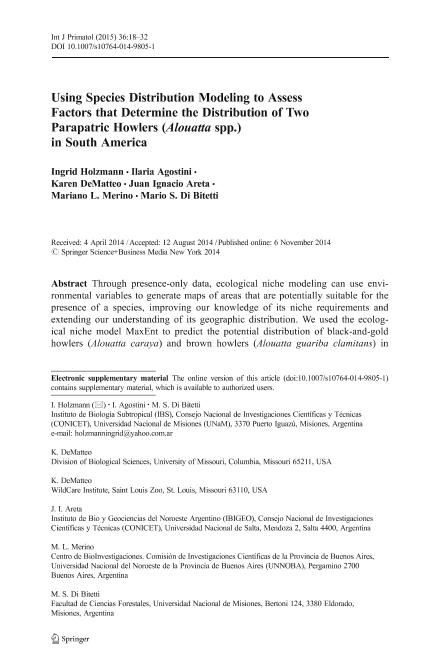Mostrar el registro sencillo del ítem
dc.contributor.author
Holzmann, Ingrid

dc.contributor.author
Agostini, Ilaria

dc.contributor.author
DeMatteo, Karen
dc.contributor.author
Areta, Juan Ignacio

dc.contributor.author
Merino, Mariano L.
dc.contributor.author
Di Bitetti, Mario Santiago

dc.date.available
2016-07-15T19:15:00Z
dc.date.issued
2015-02
dc.identifier.citation
Holzmann, Ingrid; Agostini, Ilaria; DeMatteo, Karen; Areta, Juan Ignacio; Merino, Mariano L.; et al.; Using species distribution modeling to assess factors that determine the distribution of two parapatric howlers (Alouatta spp.) in South America; Springer; International Journal of Primatology; 36; 1; 2-2015; 18-32
dc.identifier.issn
0164-0291
dc.identifier.uri
http://hdl.handle.net/11336/6550
dc.description.abstract
We used the ecological niche model MaxEnt to predict the potential distribution of the brown howler monkey (Alouatta guariba clamitans) and the black-and-gold howler monkey (Alouatta caraya) in South America, as well as the potential sympatry area between both species. We used 271 presence localities for A. caraya and 127 for A. guariba clamitans and 8 and 13 (respectively) bioclimatic variables from WorldClim to build a MaxEnt model in which habitat suitability was categorized as low, moderate or high presence probability. The black-and-gold howler monkey shows a broader potential distribution, occupying a wide variety of habitats in an ample range of temperatures. Temperature annual range (Bio 7) was the bioclimatic variable with the most influence in modeling this species potential distribution. The brown howler monkey was more restricted to rainy areas of mature forests that are placed in higher altitudes with low minimum temperatures. Mean temperature of coldest quarter (Bio 11) was the bioclimatic variable with the highest influence in this model. Predicted potential sympatry area between both species resulted in a relatively small area placed in the interior Atlantic Forest ecoregion. The Paraná river as a natural barrier for dispersion, differences in niche requirements and potential interspecific competition could be some of the causes that maintain a narrow zone of overlap between these two howler monkey species.
dc.format
application/pdf
dc.language.iso
eng
dc.publisher
Springer

dc.rights
info:eu-repo/semantics/openAccess
dc.rights.uri
https://creativecommons.org/licenses/by-nc-sa/2.5/ar/
dc.subject
Alouatta Caraya
dc.subject
Alouatta Guariba Clamitans
dc.subject
Maxent
dc.subject
Potential Geographic Distribution
dc.subject.classification
Zoología, Ornitología, Entomología, Etología

dc.subject.classification
Ciencias Biológicas

dc.subject.classification
CIENCIAS NATURALES Y EXACTAS

dc.subject.classification
Ecología

dc.subject.classification
Ciencias Biológicas

dc.subject.classification
CIENCIAS NATURALES Y EXACTAS

dc.title
Using species distribution modeling to assess factors that determine the distribution of two parapatric howlers (Alouatta spp.) in South America
dc.type
info:eu-repo/semantics/article
dc.type
info:ar-repo/semantics/artículo
dc.type
info:eu-repo/semantics/publishedVersion
dc.date.updated
2016-06-16T15:53:25Z
dc.journal.volume
36
dc.journal.number
1
dc.journal.pagination
18-32
dc.journal.pais
Estados Unidos

dc.journal.ciudad
New York
dc.description.fil
Fil: Holzmann, Ingrid. Consejo Nacional de Investigaciones Cientificas y Tecnicas. Centro Cientifico Tecnologico Nordeste. Instituto de Biologia Subtropical. Instituto de Biologia Subtropical - Nodo Puerto Iguazu; Argentina
dc.description.fil
Fil: Agostini, Ilaria. Consejo Nacional de Investigaciones Cientificas y Tecnicas. Centro Cientifico Tecnologico Nordeste. Instituto de Biologia Subtropical. Instituto de Biologia Subtropical - Nodo Puerto Iguazu; Argentina
dc.description.fil
Fil: DeMatteo, Karen. University Of Missouri; Estados Unidos. Saint Louis Zoo. WildCare Institute; Estados Unidos
dc.description.fil
Fil: Areta, Juan Ignacio. Consejo Nacional de Investigaciones Científicas y Técnicas. Centro Científico Tecnológico Salta. Instituto de Bio y Geociencias del Noroeste Argentino; Argentina
dc.description.fil
Fil: Merino, Mariano L.. Universidad Nacional del Noroeste de la Pcia.de Bs.as.. Centro de Bioinvestigaciones (sede Pergamino); Argentina. Provincia de Buenos Aires. Gobernación. Comisión de Investigaciones Científicas; Argentina
dc.description.fil
Fil: Di Bitetti, Mario Santiago. Consejo Nacional de Investigaciones Cientificas y Tecnicas. Centro Cientifico Tecnologico Nordeste. Instituto de Biologia Subtropical. Instituto de Biologia Subtropical - Nodo Puerto Iguazu; Argentina. Universidad Nacional de Misiones. Facultad de Ciencias Forestales; Argentina
dc.journal.title
International Journal of Primatology

dc.relation.alternativeid
info:eu-repo/semantics/altIdentifier/url/http://link.springer.com/article/10.1007%2Fs10764-014-9805-1
dc.relation.alternativeid
info:eu-repo/semantics/altIdentifier/doi/10.1007/s10764-014-9805-1
dc.relation.alternativeid
info:eu-repo/semantics/altIdentifier/doi/http://dx.doi.org/10.1007/s10764-014-9805-1
Archivos asociados
